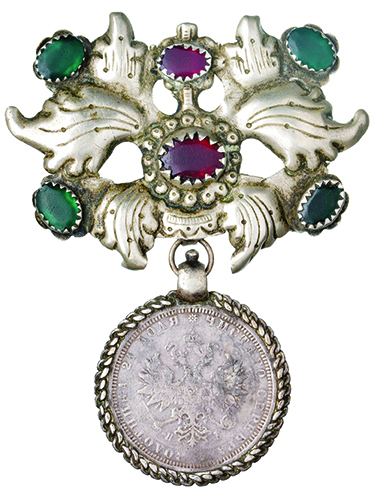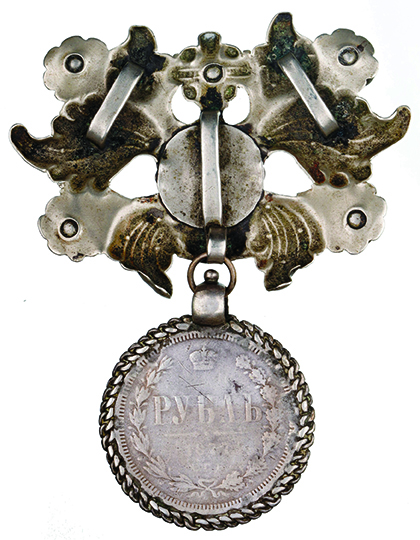Andriy Boyko-Gagarin, Ph;
Mykola Yefremov (Kyiv)
Coins of the Russian and Austro-Hungarian empires in Ukraine had a traditional use. Placed in a frame with a bow inlaid with stones in a coral necklace, they were transformed into dukachas. A common element of women's jewelry in folk use consisted of a frame with a circulating coin inserted inside and a stylish bow decorated with semiprecious stones.
There are many criteria by which antique rarities should be evaluated. Each item requires a separate approach, knowledge of the features and signs that show the true value of antiques. Every year the value of antiques is growing, so you need to clearly understand the intricacies of their valuation.
An antique is an object of cultural and artistic value that was created more than a hundred years ago. In rare cases, antiques can be products made less than a century ago. How to properly evaluate antiques and antiques?
Parameters for evaluating antiques:
Authenticity. The most important aspect of evaluating an item is its true origin. If the product is fake, there can be no question of any belonging to the antique.
Rarity of the object. The degree of rarity is a determining factor in estimating the value. The fewer analogs of a particular thing exist, the higher the price.
Age. It is quite obvious that the older the item, the higher its value.
The value of the source materials. Products made of precious metals and stones, expensive wood and other valuable components are valued very high.
Historical value. If the creation is timed to coincide with a historical event, the value increases significantly. For example, coins made in honor of a certain military victory are more expensive than those whose production is not associated with any important milestones in history.
The uniqueness of the work. It happens that an item is made using a technique that is impossible or extremely difficult to repeat in our time.
The condition of the item. This is one of the most important factors in assessing the value of antiques. Restoration significantly reduces the value of an object.
Often, the place and era of manufacture of an antique are important.
The appraisal is carried out in several stages: checking the antique for authenticity; determining the value of the item, taking into account information from auctions; examination of precious metals or stones, if any.
Final price and conclusion
An antiques appraiser must be an expert in several fields. However, it often happens that one person does not have all the necessary knowledge and skills, and the help of third-party specialists is often required. These can be art historians, restorers, historians, booksellers, and even gemologists. As a rule, all these people work in museums and art galleries, expert laboratories. Expert evaluation is paid for separately, and the costs are not included in the price of the antique. During the examination, the specialist must make sure that the work of art is not wanted.
Investments in antiques usually bring good returns in the future. This is due to the fact that the value of antiques is constantly increasing. Antiques are rightly considered one of the safest assets to invest in. It is not necessary to buy something big right away, you can start with a coin or a small piece of furniture. Therefore, the issue of competent and reasonable valuation of cultural property, including dukachas, is extremely important.
Some antiques are valued in accordance with special rules. More than half of the value of a piece of jewelry directly depends on the precious metal sample. If the jewelry is encrusted with diamonds, emeralds, rubies or other precious minerals, the value will be calculated depending on the purity, weight and rarity of the stone.
The basis of cultural property expertise is the ability to navigate among samples of cultural property, determine artistic, historical, scientific, and museum value, identify characteristic features of works of art, and determine their value and preservation.
Cultural property is property that belongs to a certain group: social, artistic, ethnic, historical, material, spiritual, and of scientific value. All of them can be expressed by certain forms of art: personal, inherent in a certain gender or age, values of large or small groups of people, different eras and states, universal. Therefore, in science, cultural values are usually divided into two main groups. The first includes the cumulative achievements of intellectual, artistic and religious creativity (outstanding architectural structures, unique achievements of crafts, archaeological and ethnographic rarities, etc.), and the second includes those cultural values that have justified themselves, proved their effectiveness in practice (customs, stereotypes of behavior and consciousness, evaluation, opinions, interpretations, etc.) and lead to the integration of society, the growth of mutual understanding between people, their solidarity, and mutual assistance.
In practice, both groups of cultural values form the basis of any culture and determine its uniqueness. To find out the true value of a dukach, the first step is to have it evaluated by an expert to establish authenticity.
Here are some peculiarities of the evaluation of traditional women's jewelry - dukachas - that exist on the antique market in Ukraine. The factors that affect the monetary valuation of a dukach are: the rarity of the coin inserted into the frame, the rarity of the type of dukach, and the state of preservation.
The rarity of the coin inserted into the frame and its state of preservation. It is quite common for a master jeweler to replace the original coin that was inserted into a ducat, if it is rare, with a more common and cheaper coin. In some types of dukachs, a coin that is not rare but expensive may be initially inserted into the frame. For example, in Volyn-type dukachs, gold four-ducat coins of Austria-Hungary were often used in the frame, which are valued at a high price due to the significant amount of precious metal they are made of. If a rare coin, such as an authentic Catherine the Great's chervonets, is preserved in the frame of a dukach, its value and attractiveness on the collector's market will be much higher. For example, in dukachs of the Slobozhansky type, one can often find rubles of Peter I or Peter II or even Peter III, which are rare in themselves.
Rarity of the dukach type. Among the known types of ducats, which are distributed mainly according to the region of their distribution, experts distinguish between more and less rare, and, accordingly, which can be more or less valued, since the demand on the collector's market will be higher for rarer ducats. For example, the most common type of dukach is the Veremiivka dukach, the rarest is the Kursk dukach, and the "apple tree savior" type is highly valued, even though most of these dukachs are made of non-precious metal. This type of dukach may have a gold insert with the image of Jesus Christ, which significantly increases its value. Sometimes even common types of dukats may contain interesting rare features, such as uncharacteristic distinctions made in the form of a bow; the presence of gilding on the bow of a common type of dukat, which is usually found without gilding.
The state of preservation - the presence of defects or careless unprofessional restoration interventions, traces of corrosion or damage, etc., which also affects the monetary value.
We express our sincere gratitude to Maksym Ochkur
for his recommendations and comments on this topic.


A dukach with a bow, nineteenth century. Found on the border of Chernihiv and Poltava regions*.
* Museum of Money: a popular science catalog / Edited by D. Tolochko, A. Boyko-Haharin, R. Rilov, M.-M. Kostiv. - Kyiv: Sprint Service, 2021. С. 31.
Materials provided by the publisher of the journal "Numismatics and Phaleristics" https://www.numismatics.kiev.ua/
